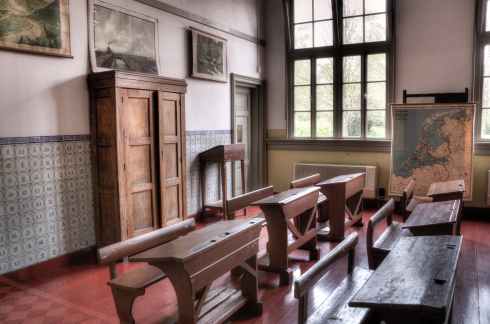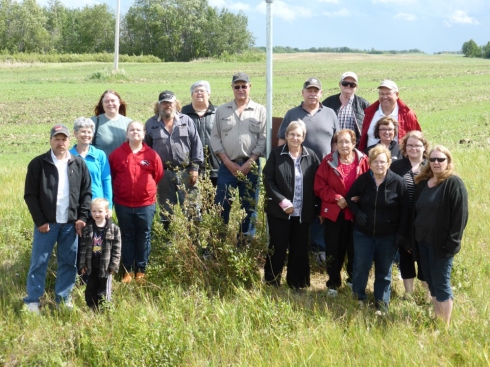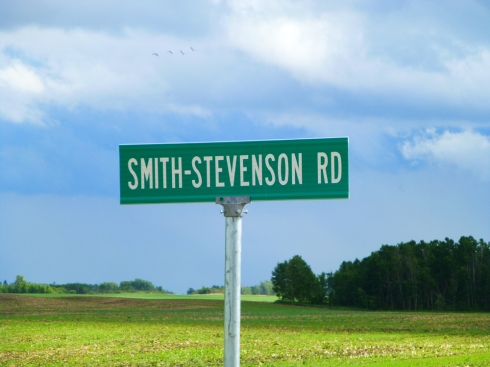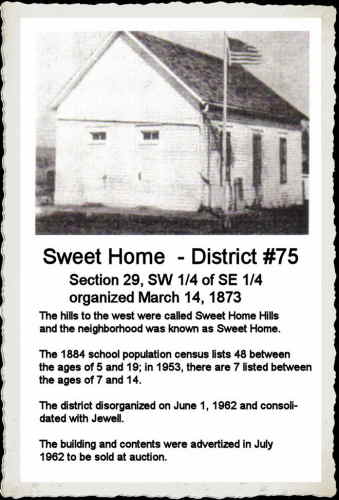
Grandmas Memories
Written for my Dear Grandson
Elexander Menzie-Smith
(Durward Alexander Smith) written by Eliza M. Wilder
…..
My grandpa’s picture was taken about June or July of 1909 at my childhood home at Swans Trail – Route 2 Near Snohomish Washington, About 3 miles from Everett. My Parents George Perry Stevenson and Susan Evalena Stevenson. Isaac Stevenson aged about 94 years old at the time. My sister Bertha and brother George Edward Stevenson and myself.

Stevenson Family in 1909 Back row: Bertha Amelia Stevenson (First Married to John Nelson and then to George Elwood Smith), George Edward Stevenson, Middle Row: George Perry Stevenson, Susan Evalena Stevenson, Isaac Stevenson, Front: Eliza Mae Stevenson,Note Eliza Mae Stevenson (first married to Henry Smith and then Richard A Wilder) Eliza Mae Stevenson ~ age about 6 years old at the time when we came from our home in Kansas and Daddy bought our home in Swans trail between Everett and Snohomish Washington. We had 20 acres there a big house and fine orchard. {Photo copyright Gordon Neish}

Isaac Stevenson – 1909
…..
Grand father had been very sick shortly before we sold our home in Kansas and came here. In fact given up by the doctors, he recovered and lived to a ripe old age. We stayed in Washington for around 7 years in which Grandpa kept himself very busy and happy working an he and Papa cleared quite a large pasture and how he enjoyed seeing the large stump piles as they burned, and he chunked them up and kept the sparks flying, and he often came in carrying a large, rail size piece of wood, and cut it up for use in the large old fire place where he loved to sit an smoke an tell the stories of his life in the many States he had lived in. While the rain and fog made the outside cold and chill after his years in hot old Kansas, where we had lived and farmed for many years. Those years flew by and Daddy decided he would move again and go to Sask. Canada where homesteads were still available and consisted of 160 fertile acres of wonderful land for each person homesteading there.
…..
So in 1910 all was put in readiness and when the school term was out I left my lessons in school and we all went to Canada. Where indeed we all learned many of life’s lessons. We left here in the spring of 1910. Daddy and another friend and business man and family chartered a rail road car and each took with up our cows, horses and other necessities, house hold furniture and brother Ed traveled with the stock on the trip to care for and feed them on the train. The rest of us got our tickets and went in a passenger train from Washington into Saskatchewan province (or State). It took several days as the trains were very slow up there and as soon as we were on our way we soon reached the mountains that were yet full of deep snow and big storms kept us here and there waiting for hours for the rail road to clear so we could go on. We took with us a large (telescope suit case) in which we packed our family meals or lunches. We made sandwiches bought our coffee made hot by the porter in a large coffee pot and some times when we had to stop for a while at some town we could go into a grocery store for more supplies.
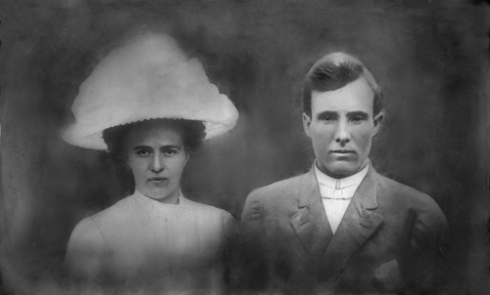
George and Bertha’s Wedding. Photo copyright Gordon Neish
…..
I sure enjoyed looking out on the winter scenes and many beauties of the trip. Landscape changed as we moved along. At night time full size bed were allowed by pulling out the seats and so we all had good beds to sleep in. I loved to hear the trains whistle and bells ring. We finally got away from the beautiful mountains and out into the wide open spaces as we traveled along through Alberta and different provinces. When we got to Sask., there was many large elevators by the train tracks, where the thousands of bushels of wheat, oats and barley was stored, taken there by the many farmers near by.
…..
Spring is late up there and there is a rush to get the crops planted as the earth is frozen hard and cannot be worked much until May. So all gardens must be planted as soon as possible and must be harvested likewise in Sept. as the ground starts to freeze solid in early Oct. and November.
…..
As we got into Sask. we found the country not so settled and we was to our destination, as we unloaded and left the train at a little town called Munster Sask. We found it a small place one street, store and a few other business places, large elevators for grain and a livery stable. A small residential section and out of town a short distance was a large monastery and Nunnery with a smaller log building where the church held its meetings and many came for miles to attend mass and other services very early in the morning.
…..
Daddy finally located a small house which he rented an at last we could have a rest while we awaited the furniture and live stock. They arrived in about 2 or 3 weeks and then we must get on by Ox team until we found our home in the wilderness. Daddy looked around several days and found in what direction they would go to look for suitable homesteads and also bought a new lumber wagon and a very large team of snow white Oxen harnesses and equipment to start out in a new part of the world where there was unplowed wilderness and very few if anyone yet living.
…..
Moving day came, we loaded our few possessions, groceries and tools, 2 large tents, a stove and bedding. Climbing into the lumber wagon somehow we got set and our journey began. We started out of the mall town of Munster and into the neighboring vicinity, about 16 miles out there was another small village with a few business places an store. This town was called Anaheim and had its farmers scattered on neighboring farms where people were just nicely started with their cattle and fields of grain. Going on further we soon come on fewer ranches and roads so we followed along on the edges of the swamp ground and the trees were away from the swamps some giving plenty of room to travel by picking our way. We went by many small shallow lakes full of wild geese and ducks and many noisy water birds. Around these low places many lovely wild flowers grew. By the time we got moved springtime ad really come. It was time we must hurry wish our preparations for a home. However we kept on until we sighted three dwellings and realized that someone else had started there also before we came. So as we didn’t know yet just where we would be, we asked to pitch our tents and look around for a homestead while near these people’s homes. We pitched the two large tents, put up our small stove an made up our beds for night in our jungle wilderness. Sometime later the men got out and found homesteads a few miles north of where we were camped. An old neighbor we had met in Kansas came to us and they too found home sights near by.

…..
We hurriedly hauled a few popular logs an threw up a cabin for the families for the coming winter, plowed up a small space to put in a garden, potatoes, cabbage, turnips, carrots, beats, lettuce and radishes. Not much else could mature in the short time it would have before the cold weather came on, Our men got out and cut wild hay for the long 9 month winter ahead everyone was busy. They found places and filed on them. Grandpa filed on 160 acres also my Daddy filed on one also my brother Ed filed on one and my sister bertha now married an had a baby son Earl Nelson. Earl and Fred were babies when we left Washington to go to Canada. Earl was about 2 years old and Fred only 4 or 5. I was 13 that spring April 17, 1910.…..
There was much tall wild hay around those lakes and while I and Grandpa baby sat at home the men folks mama and sister Bertha cut hay an turned it if needed, finally loading it into large hat racks which they hauled it home in. stacking it in large stacks by the barn and chicken house for winter feed. A frame was made and covered with a straw stack for a chicken house.
…..
We milked 3 cows, had our own meat and vegetables, bought grain and had our own flower ground. We dug a cellar under the house floor in which we kept our vegetables and canned fruit. Sending out to a mail order house we bought the things we couldn’t grow and laid in our supply for the long winter months, medicines etc.
…..
Ed and Fred enjoyed duck hunting up there. There was birds and ducks by the thousands and many of wonderful meal they made. I loved to listen to the wild birds and heart the wild water birds called loons cry, it sounded like they were laughing.
…..
Mosquitoes were terrible, one could not enjoy the beautiful outside because of them. One had to prepare smudge pots they were so bad day and night, no happy picnics there for sure. If one walked out they got a handful of brush and kept them in the hand to brush on one side an then on the other each step.
…..
We cleared land plowing it up for the first time with large plows called brush breakers. We planted grain by hand. We drove our Ox teams to town. It took 2 days to get 32 miles to town and back. We had to take time to let the team rest and eat. And we stay in a hotel overnight, collected what we wanted and returned. Oxen can’t go fast like horses do or fly like a care.
…..
The year I was married 1912 I helped papa break new ground, several acres with the oxen. One has to plow right through big willow bunches sometimes breaking the plow or harness. One ox gets tired or mad an lays down, one has to get him up an coaxed to go, by that time the other one probably rams through the harness tearing it to pieces or lays down in it and refuses to get up. Finally night comes and weary with the toil of a hot day unlosses the oxen from the plow and heads for the barn with millions of mosquitoes following like swarms of bees. The team taken and rubbed down to roll the mosquitoes off their sides. Then they are turned loose fed and watered for the night and rest for the same procedure on the morrow. While daddy and I tired out worn thread bare and cross from shear aggravation, clean up and wash away the sweat and dust and try to rest our weary bones too. Mama would have a nice warm supper for us and when the milking was done and dishes were done, we were glad to crawl into our beds and sleep till morning.
…..
In fall we would take the team sometimes and go to the shallow lake sides and gather sacks of big brown cattails a reed that grows even here on swampy land. These we hauled home and we took the plush of off them to make pillows and bed ticks from. We dried them, shelled the fuzz from the stems an stuffed it into pillow ticks for pillows and into large ticks for substitute mattresses. These was placed on top of large ticks filled with fresh clean straw. We bought heavy woolen blankets and made our own sheets and pillow cases and quilts. Any good clean pieces of material was made into peaced quilt tops an old blankets or wool or cotton used for padding, then lined with any good material. They were pretty nice in 30 or 60 below weather, before our 9 months of winter was gone. Believe it or not.
…..
In summer smudges was necessary around our meager log houses to drive out the countless mosquitoes and many kinds of biting flies and was carried into the houses so we could smoke the insects out before retiring.
…..
About 2:30 AM or 3 o’clock morning would come with the bright dawn the frogs wake up an hundreds of water birds songs filled another beautiful sun shinny morning and mostly all day. And became hot real hot in summer time many beautiful flowers and gobs of mosquitoes was our daily torment. Sometimes I would venture out an get a bouquet of lilies and wild roses and take with me a bunch of willow limbs to brush the attaching army of mosquitoes fallowed right with one every step of the way. It almost seemed the wild flowers grew thick along the shallow Sask. Can. lakes and swamps by the time the snow was gone. Some flowers was blooming in the little open spots and was welcomed as was also the frogs song and singing birds after the long nine month winter usually about 35 an 40 below zero, but some winters as low as 64 below in February where we were.
…..
The years of 1911 and 1912 was very wet years when the snow finally melted and was gone it turned to raining and much thunder and lightening storms all around us. It rained and it poured and one could see to read many times when the lightening flashed from many directions all around us. Waking up in the night to find the roof which was covered with sods from the land near the lakes as people did in Kansas years before, had soaked up its capacity of water and finally it poured out wetting up whatever was beneath it. So out of bed we would scramble using whatever was available to catch the water so we could again get back to sleep a bit longer for day would soon come and there was much work and chores to be done every day. Milking, feeding, gardens to plant and tend by hand, everything to make at home for the homesteaders who had gone to get a start in the fields of a new homesteading area in Sask. Canada. This rainy weather was about like Washington some years. Terrible for many homesteaders had no money for tools machinery or even horses let alone cars or trucks. They were poor folks having to get along as best they could and be thankful.
…..
The doctors which was few was from 32 miles to 70 miles from us, so were seldom called on. In emergencies someone would go for a doctor as far away as 70 miles in the terrible weather 64 below zero.
…..
Grandpa Stevenson was buried up there also sister Bertha, Earls mother. Lena (Hilda) Ed’s wife and baby Woodrow and my baby Howard.
…..
After the homesteads were finally taken and each family each family knew where they were to live houses had to be built. On Grandpas place which joined daddy’s homestead, a little further to the east was Bertha’s place and Ed’s was farthest north. Henry’s place joined Bertha’s and Mr. Smiths joined ours. Later Fred Smith bought Grandpas place and George Smith Jr. lived north of his dad.
…..
We built on our place not far from Berthas. It was a beautiful place, we were about 9 miles from a wilderness store but had to forge a 2/3 mile lake to get to this store. This store was a short distance from our house. By this time we had learned never to trust going from home without food and bedding as the climate is very treacherous up there especially in cold weather. No roads and only Ox team and one never knew what might befall on even a short trip. We made it 9 miles to the store and returned soon as we had got our supplies only to find that we were on the far side of the lake from home and it had frozen over so hard we wee unable to drive back through the lake as we had come a few hours before. We drove down to cross back home but the Oxen could not make it. They went into the water with their front feet but could not break the ice to continue an pull the heavy lumber wagon through the lake. Only a mile and a half from home. We finally gave up and managed to get safely back on the land out of the lake an realized we must make camp and stay until the next morning. Luckily there was still part of a grainy building the people that had had the place had burned out. So we quickly loosened our team and got ready to make the best of the situation. We were thankful to have food and bedding with us and there was old hay to make a place to sleep under the roof. We managed to keep fairly warm. Next morning we awoke and found we would have to travel several miles among the trees along the swamp and strike a road coming down another way to get home. Believe me we learned never go anywhere unless you went prepared for any emergency.
…..
Another time we started out to go 32 miles to the depot to pick up uncle Cabe when he came to Canada. Mr. Smith and Fred Smith was with us but our team got sick, refused to travel an Fred and his dad got out and walked into town and when they found Cabe they started walking to find us But we didn’t get home for several days, until after they got home. This time caused by the old Oxen getting sick.
…..
Another time we had a sick team coming home on April 1st. This time we was 5 mile from home when we just couldn’t get them to continue. We went into a school house and managed to keep from freezing. The weather had got colder and we were surely thankful to find the doors unlocked and plenty of wood to keep us warm. Also another poor hitchhiker that caught a ride with us, we got home next day.
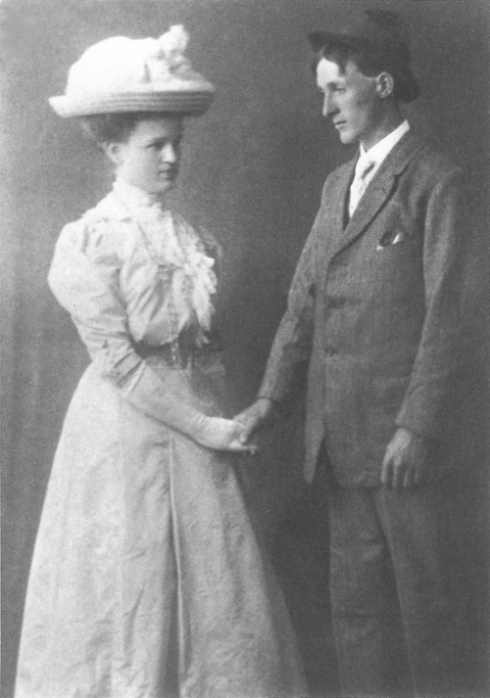
…..
Henry and I stayed in Canada until 1914 and when Elma a few months old we came back to Everett where we remained until 1917 and went back to Canada. Our house was burned down and we faced a 9 month winter with out a place of our own. Then we later put up another house but sold the homestead and returned in 1919. We rented a place in Everett Washington.
…..
But I liked Canada. It may have outgrown some of the hardships. The shallow lakes dried up as the land became tilled an great crops of grain now raised there. I have never got to go back.
Written by Eliza M. Wilder for my grandson Buzzie Smith
Buzzie, Pat said she would like to copy this, Maybe you would let her copy this.
Thank you,
Grandma.
Tribute to Gordon Neish July 20, 1954 – June 14, 2020 You Tube
Rural Municipality of Pleasantdale No 398, Gordon Neish, Kermaria SW 16-41-19-W2, Lac Vert SW 2-41-18-w2, Ambles NE 16-40-20-W2, Naicam NW 2-40-18-W2Saskatchewan, Canada, Saskatchewan, Saskatchewan, Canada, photographs, photos, Kermaria SW 16-41-19-W2, Lac Vert SW 2-41-18-w2, Ambles NE 16-40-20-W2, Naicam NW 2-40-18-W2, STEVENSON George Edward, SE34-40-19-W2, Great uncle,
SMITH George Elwood , NW27-40-19-W2, Grandfather,
SMITH George Israel , SW27-40-19-W2, Great Grandfather,
SMITH Henry Ernest, SE27-40-19-W2 , Great uncle,
HOWE John, NE21-40-19-W2 , ,
STEVENSON Isaac , NW22-40-19-w2 , Great Great Grandfather,
NELSON Bertha Amelia , NE22-40-19-w2, Grandmother,
STEVENSON George Perry, SW22-40-19-w2 , Great Grandfather,
SMITH Lott Cabe , NE23-10-19-W2, Great uncle, Smith Stevenson Road,
NOTICE: This Rootsweb/Ancestry.com page was saved on Internet Archive’s Wayback Machine by searching for the original page http://www.rootsweb.ancestry.com/~cansk/RoadsInSaskatchewan/GrandmasMemories.html!!! Rootsweb/Ancestry.com is down. It is the intention of this site to make this historical submission available to persons with a historical or genealogical interest.. There are no service charges or fees for personal use of these photographs, or transcription services and use of this site constitutes your acceptance of these Conditions of Use. These electronic pages and photographs are under copyright may NOT be reproduced in any format for profit. Persons or organizations desiring to use this material commercially, must obtain the written consent of the copyright holders and submitter: Gordon Neish and contact Saskatchewan Gen Web Webmaster, Julia Adamson with proof of this consent.
copyright © Web Publish Date: Fri Dec 18 2015 All Rights Reserved
Many thanks are extended to Gordon Neish for this submission share online.
Rural Municipality of Pleasantdale No 398,
Gordon Neish,
Kermaria SW 16-41-19-W2,
Lac Vert SW 2-41-18-w2,
Ambles NE 16-40-20-W2,
Naicam NW 2-40-18-W2
Saskatchewan, Canada, Saskatchewan, Saskatchewan, Canada, photographs, photos,
Kermaria SW 16-41-19-W2,
Lac Vert SW 2-41-18-w2,
Ambles NE 16-40-20-W2,
Naicam NW 2-40-18-W2,
STEVENSON George Edward, SE34-40-19-W2,
Great uncle,
SMITH George Elwood , NW27-40-19-W2,
Grandfather,
SMITH George Israel , SW27-40-19-W2,
Great Grandfather,
SMITH Henry Ernest, SE27-40-19-W2 ,
Great uncle,
HOWE John, NE21-40-19-W2 ,
STEVENSON Isaac , NW22-40-19-w2 ,
Great Great Grandfather,
NELSON Bertha Amelia , NE22-40-19-w2,
Grandmother,
STEVENSON George Perry, SW22-40-19-w2 ,
Great Grandfather,
SMITH Lott Cabe , NE23-10-19-W2,
Great uncle,
Smith Stevenson Road,
Tags: Ambles NE 16-40-20-W2, Bertha Amelia Stevenson, Durward Alexander Smith, Elexander Menzie-Smith, Eliza M. Wilder, Eliza Mae Stevenson, George Edward Stevenson, George Elswood Smith, George Israel Smith, George Perry Stevenson, Grandfather, Grandmother, Great Grandfather, Great Great Grandfather, Great uncle, Henry Smith, HOWE John, Ida Mae Hodges-White, Ina Smith, Isaac Stevenson, Jacob Lyman Schoonover, John Nelson, Kamsas, Kermaria SW 16-41-19-W2, Lac Vert SW 2-41-18-w2, Lena Smith, Marion Smith, Mellisa Melvina Bonine, Naicam NW 2-40-18-W2, NE21-40-19-W2, NE22-40-19-w2, NE23-10-19-W2, NELSON Bertha Amelia, NW22-40-19-w2, NW27-40-19-W2, Richard A. Wilder, SE27-40-19-W2, SE34-40-19-W2, SMITH George Elwood, SMITH George Israel, SMITH Henry Ernest, SMITH Lott Cabe, Smith-Stevenson Road, Snohomish, STEVENSON George Edward, STEVENSON George Perry, STEVENSON Isaac, Susan Evalena Stevenson, SW22-40-19-w2, SW27-40-19-W2, Washington, Willard Smith


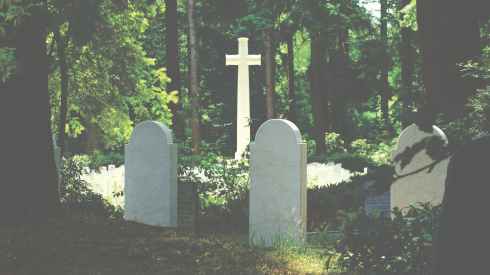

 1954 Canadian National Railways Western Lines Map (Western Canada)
1954 Canadian National Railways Western Lines Map (Western Canada)
